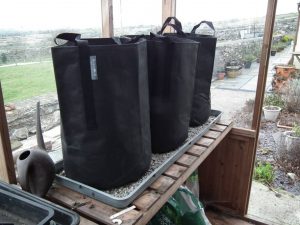Growing potatoes in bags is a great way of getting a useful crop from a small space. If you have a greenhouse then you can also get a very early crop. Usually by the time the first crop of the season arrives, the maincrops are near past it. A super early potato crop bridges the gap.
 In this article I’m covering growing potatoes in 40 or 50 litre bags. Growing in the smaller 17 or 20 litre bags is covered in the Growing Potatoes for Show section.
In this article I’m covering growing potatoes in 40 or 50 litre bags. Growing in the smaller 17 or 20 litre bags is covered in the Growing Potatoes for Show section.
What varieties to choose when growing potatoes in bags
The obvious varieties to grow would be first earlies like Arran Pilot, Swift or Rocket but you might prefer to grow a second early salad variety like Charlotte or Anya.
You’re not limited to those varieties – you might like to try International Kidney which is the variety that gives the famous Jersey Royals. Using your greenhouse, you might even have Jersey’s on your table before they’re in the shops.
Avoid maincrop potatoes as they’re generally not the best for container growing.
Compost for Growing Potatoes in Bags
Start with a good quality multi-purpose compost. This may cost a little more but will give a better result. One tip from the show growers to get near-perfect skins on your potatoes is to pass the compost through a shredder to get a fine mixture. It’s worth doing with cheap shop-bought composts that tend to have twigs and bits of wood in.
If you don’t buy in multi-purpose compost then you can mix your own with home-made compost, sifted garden soil and leafmould. Leafmould combined with Russian comfrey leaves provides both growing medium and additional potash to aid growth. Do not add lime to the compost.
Most multi-purpose composts have enough nutrients to carry through for 6 weeks which is not enough for the potatoes that will take between 12 and 16 weeks to crop so you need to add additional fertiliser.
A specific potato fertiliser mix at N6:P10:K10 is best or Vitax Q4. If you don’t have a specific potato fertiliser; fish, blood & bone is better to use as a fertiliser than Growmore as the nutrients release more slowly. Mix around 250 to 400 grams of fertiliser per 100 litres of compost
Finally add some water retaining crystals to the compost as per the instructions on the pack. This avoids the bag drying out if you miss a watering.
Cultivation for Growing Potatoes in Bags
I like to place a layer of turf on the base. Ordinary lawn turf taken up the previous year and stacked grass side down is perfect. The mass of roots from the grass holds it together and it acts as a sponge to hold a water reserve.
Add a further 15 to 20cm (6 to 8″) of your compost mix into the bag and set 2 or 3 seed potatoes, chits or eyes up, into the compost and cover with another 15 to 20cm layer of compost.
Once the leaves start to show about 20cm (8″) above the surface, add some more compost to half-way up the leaves. Keep repeating as the haulm grows, adding the compost slowly, layer by layer, until you get to the top of the bag
It’s critical to keep watering, usually daily when growing strongly. Potatoes like a lot of water. You don’t want the compost soaking wet but moist all through.
If you can, use rainwater from a water butt rather than tap water. Tap water often has a neutral to high pH (alkaline) and potatoes prefer to grow in somewhat acid soil with a pH of 5.5 against the 6.5 / 7.0 preferred by most of our vegetables. In more alkaline soils they often develop scab which is very unattractive in new or salad potatoes.
Once the bag is filled, feed weekly with a liquid tomato fertiliser instead of watering that day.
Greenhouse Growing Potatoes in Bags
You can start off any time from February onwards. It is important that the greenhouse is frost free and ideally has a daytime temperature over 10°C. Place on gravel trays so as not to block the drainage holes in the bottom of the bag.
Harvesting the Crop
Once the plants flower which is the indicator that the tubers are forming and probably ready. Scrape some compost out and if the tubers seem OK, empty the bag and gather up your crop.
The spent compost can be re-used for flowers or crops other than potatoes, tomatoes, aubergines which are the same family.
Potato Growing Articles
- Growing Potatoes Overview – How to Grow Potatoes Guide
- How Many Seed Potatoes are Needed
- Potato Flowers, Fruits, Seeds & Breeding
- Growing Potatoes – Standard Traditional Method
- Growing Potatoes Under Straw Mulch
- Growing Potatoes Under Black Plastic (Polythene) Sheet
- Potato Growing in Raised Beds & Ridge Planting Potatoes
- Growing Potatoes in a Barrel – Patio Growing Potatoes
- Growing Potatoes in Bags | Greenhouse Potatoes
- Second Crop Autumn Planted Christmas New Potatoes
- Can you chit supermarket potatoes?
- Potato Varieties for Flavour -Boiled Baked Roasted Mashed
- Potato Fertiliser Program Program & (NPK) Requirements
- Potato Blight Cause, Identification. Prevention, Treatment Potato Blight
- Wireworm in Potatoes Cause Identification Prevention Control Potato Wireworm
- Eelworm Potato Cyst Nematode – Control Potato Eelworm
- Dry Rot in Potatoes Cause Identification Prevention Control of Potato Dry Rot
- Potato Scab – Common Scab in Potatoes
- Potato Scab – Powdery Scab in Potatoes
- Hollow Heart, Splitting & Spraing Potatoes
- White Spots on Potatoes Lenticels & Potato Stem Rot
See Also:
- Growing Potatoes for Show, Introduction & Best Varieties
- Growing Potatoes for Show, Cultivation of Show Potatoes
- Growing Potatoes for Show Harvest & Showing Potatoes



